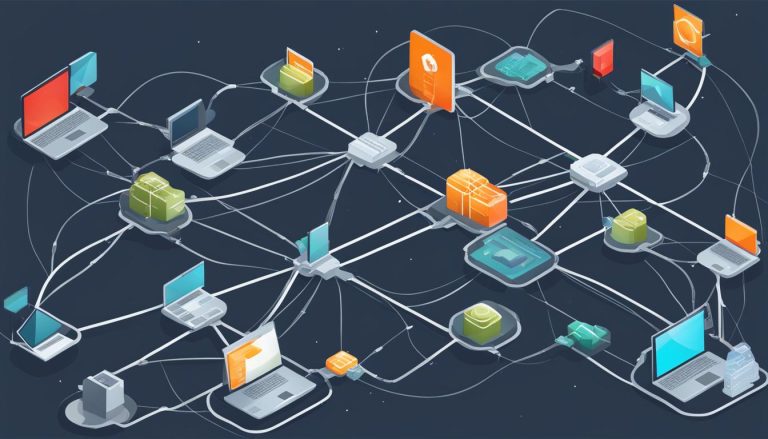In the world of cloud computing, resource pooling is a fundamental concept that plays a crucial role in optimizing the utilization of resources. But what exactly is resource pooling?
Resource pooling refers to the practice of serving multiple clients or tenants with scalable and provisional services. It involves the creation of a pool of resources, such as computation, network, and storage, that can be dynamically allocated based on user demand. This pooling of resources enables efficient usage and optimization of resources in cloud data centers.
There are various types of resource pools, including physical server pools, virtual server pools, cloud storage device pools, and network pools. These pools can be organized and managed effectively using hierarchical structures.
Key Takeaways:
- Resource pooling is the practice of serving multiple clients or tenants with scalable and provisional services.
- It involves creating a pool of resources that can be dynamically allocated based on user demand.
- Resource pooling enables efficient usage and optimization of resources in cloud data centers.
- There are various types of resource pools, such as physical server pools, virtual server pools, cloud storage device pools, and network pools.
- Effective organization and management of resource pools can be achieved using hierarchical structures.
Benefits of Resource Pooling
Resource pooling offers several advantages in cloud computing. Firstly, it allows for high availability of services, ensuring that users have access to the resources they need without any downtime. This is crucial for businesses that require consistent and uninterrupted access to computing resources to carry out their operations efficiently.
Secondly, resource pooling helps in load balancing, which involves distributing the workload evenly across the available resources. By efficiently managing the allocation of resources, resource pooling improves overall system performance and prevents any single resource from being overburdened. This ensures that each user gets their fair share of resources and experiences optimized performance.
Furthermore, resource pooling provides a high computing experience to users by offering flexibility and scalability. Users can dynamically scale their resource usage based on their changing needs, allowing them to optimize resource utilization and avoid unnecessary expenses. This level of flexibility enables businesses to adapt quickly to fluctuations in demand without making significant capital investments.
“Resource pooling in cloud computing offers businesses the ability to scale their resources based on demand without significant capital investments.”
Lastly, resource pooling allows for the virtual and physical storage of data. This means that users have the option to utilize both virtual storage, where data is stored in the cloud, and physical storage, where data is stored on-site. This flexibility provides businesses with the freedom to choose the storage option that best suits their needs and requirements.
In summary, resource pooling in cloud computing brings numerous benefits to businesses. It ensures high availability of services, improves system performance through load balancing, offers flexibility and scalability, and provides the option of virtual and physical storage. By leveraging resource pooling, businesses can optimize their resource utilization, enhance operational efficiency, and adapt quickly to changing demands.
How Does Resource Pooling Work?
Resource pooling in cloud computing operates by creating a pool of resources that can be dynamically allocated based on user demand. Service providers use a multi-tenant model to serve multiple clients or tenants, treating the resources as a unified unit. This approach allows for efficient provisioning and management of services, ensuring that users have seamless access to the resources they need.
One of the key techniques used in resource pooling is virtualization, which separates user environments and enables secure and efficient sharing of resources. With virtualization, users can access their allocated resources without having to worry about the underlying infrastructure. The service provider handles the allocation and scaling of resources, ensuring a smooth and hassle-free experience.
Resource pooling brings several benefits to cloud computing. It allows for optimized resource utilization, as resources are shared and efficiently used among multiple clients. Additionally, it enables flexibility and scalability, allowing businesses to scale resources based on demand without significant capital investments. By implementing resource pooling, organizations can enhance operational efficiency and optimize resource allocation.
Key Features of Resource Pooling
| Feature | Description |
|---|---|
| Dynamic Allocation | Resources are allocated based on user demand, ensuring efficient utilization. |
| Multi-Tenant Model | Multiple clients or tenants are served using a shared pool of resources, providing scalability and flexibility. |
| Virtualization | Techniques like virtualization separate user environments, ensuring secure and efficient sharing of resources. |
| Optimized Resource Utilization | Resource pooling allows for the efficient sharing and utilization of resources among multiple clients, reducing costs and increasing efficiency. |
| Scalability | Resource allocation can be scaled up or down based on user demand, providing flexibility to businesses. |
| Seamless Resource Access | Users can access their allocated resources without worrying about the underlying infrastructure, as the service provider handles the allocation and scaling. |
Advantages and Disadvantages of Resource Pooling
Resource pooling, as discussed earlier, offers several advantages in terms of optimizing resource utilization and enhancing operational efficiency. However, it also comes with certain disadvantages that need to be considered before implementing this approach.
Advantages of Resource Pooling
1. Cost-effectiveness: Resource pooling allows for efficient utilization and sharing of infrastructure, which can significantly reduce costs for users. By pooling resources, organizations can avoid overprovisioning and make better use of their available resources.
2. Load balancing: Resource pooling enables the distribution of workloads across available resources, ensuring optimal system performance. This helps in avoiding resource bottlenecks and providing a seamless experience to users.
3. Flexibility and scalability: With resource pooling, users have the flexibility to scale their resources based on demand without significant capital investments. This allows businesses to adapt to changing needs and efficiently allocate resources as required.
Disadvantages of Resource Pooling
1. Dependency on the service provider: When opting for resource pooling, users rely on the service provider for resource allocation and management. This can lead to potential issues if the provider fails to meet the required service levels or if there are limitations in terms of resource availability.
2. Security risks in multi-tenant environments: Resource pooling involves sharing resources among multiple users or tenants. This raises security concerns, as there is a risk of unauthorized access or data breaches. Organizations must ensure robust security measures and strict access controls to mitigate these risks.
| Advantages | Disadvantages |
|---|---|
| Cost-effectiveness | Dependency on the service provider |
| Load balancing | Security risks in multi-tenant environments |
| Flexibility and scalability |
In conclusion, resource pooling offers significant advantages in terms of cost-effectiveness, load balancing, and flexibility for businesses. It allows efficient utilization of resources and better allocation based on demand. However, it is essential to consider the potential dependency on service providers and the security risks associated with multi-tenant environments. By evaluating these advantages and disadvantages, organizations can make informed decisions about leveraging resource pooling to optimize their operations and enhance resource management.
Conclusion
Resource pooling is a crucial concept that plays a significant role in optimizing efficiency and managing resources in various domains, including cloud computing and project management. By understanding the concept of resource pooling, organizations can make informed decisions to enhance operational efficiency and resource utilization.
In cloud computing, resource pooling involves serving multiple clients or tenants with scalable and provisional services. This approach allows for high availability, load balancing, and flexibility for businesses. Examples of resource pooling in cloud computing include sharing resources among multiple clients in a cloud environment, enabling efficient usage and optimization of resources in cloud data centers.
Resource pooling is also applicable in project management. By pooling project resources, organizations can effectively manage project tasks and achieve better results. This approach enables efficient utilization of resources and enhances collaboration among team members.
There are different types of resource pooling, including physical server pools, virtual server pools, cloud storage device pools, and network pools. Each type offers unique advantages and caters to specific needs. It is essential for organizations to evaluate their requirements and choose the appropriate type of resource pooling that aligns with their goals.
FAQ
What is resource pooling?
Resource pooling in the context of cloud computing refers to the practice of serving multiple clients or tenants with scalable and provisional services. It involves creating a pool of resources, such as computation, network, and storage, that can be dynamically allocated based on user demand.
What are the benefits of resource pooling?
Resource pooling offers several advantages in cloud computing, including high availability of services, load balancing for improved system performance, flexibility and scalability to meet changing needs, and the ability to virtualize and store data. It also provides flexibility to businesses, allowing them to scale resources based on demand without significant capital investments.
How does resource pooling work?
Resource pooling works by creating a pool of resources that can be dynamically allocated based on user demand. Cloud service providers use techniques like virtualization to securely and efficiently share resources among multiple users. Users can access the resources they need without worrying about the underlying infrastructure, as the provider handles the allocation and scaling of resources.
What are the advantages and disadvantages of resource pooling?
Some advantages of resource pooling include cost-effectiveness, load balancing for optimal performance, and a high computing experience with flexibility and scalability. However, there are also disadvantages, such as dependency on the service provider for resource allocation and potential security risks associated with multi-tenant environments. Users should assess their needs and evaluate the trade-offs before opting for resource pooling.
Matt is doing business in information technology since 1992. After discovering Linux he soon fell in live with Windows Operating System.


